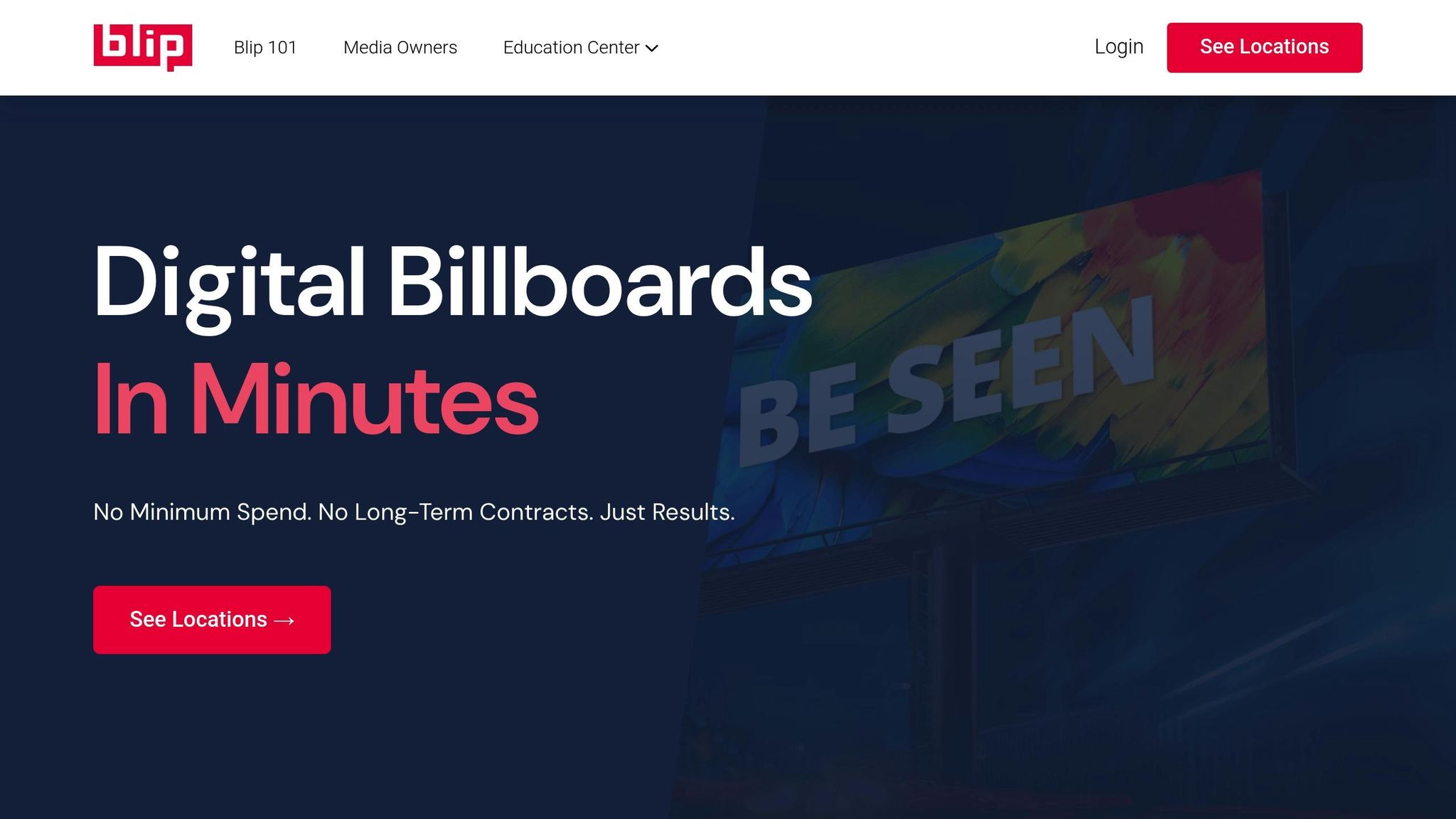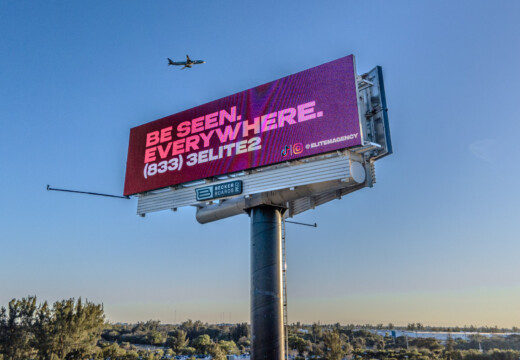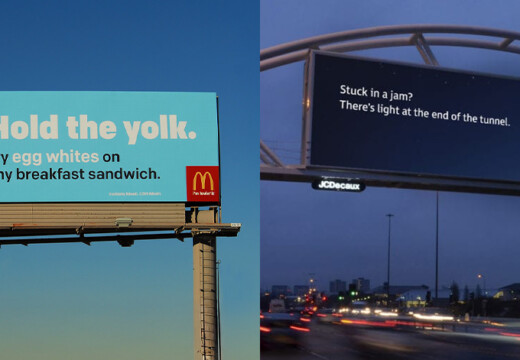Out-of-home (OOH) advertising is a powerful way for small businesses to stand out locally. Here’s a quick summary of what you need to know to plan your OOH budget effectively:
- Start Small: Daily budgets can begin at just $20, making it accessible for testing campaigns.
- Choose Locations Wisely: High-traffic areas or spots near your target audience yield better results but may cost more.
- Leverage Digital Billboards: Flexible pay-per-play models let you control costs and adjust campaigns in real-time.
- Plan Timing: Focus on peak hours and seasonal opportunities to maximize impact.
- Track Performance: Use metrics like impressions, CPM, and website traffic to measure success and optimize.
Quick Comparison: Digital vs. Static Billboards
| Feature | Digital Billboards | Static Billboards |
|---|---|---|
| Minimum Campaign | 1 day | 4+ weeks |
| Content Changes | Multiple ads per day | Fixed content |
| Production Costs | Digital file only | Physical materials |
| Setup Time | Hours | Days to weeks |
| Budget Control | Pay-per-play model | Fixed-term contracts |
With these tips, you can create cost-effective campaigns that build brand awareness and drive results for your business.
How Much Do Billboard Ads Cost? – BusinessGuide360.com
OOH Cost Factors
Planning an out-of-home (OOH) advertising campaign? Understanding the key cost factors can help you budget effectively. Here’s what you need to know:
Location Impact on Costs
Where your billboard is placed has a huge influence on its price. High-traffic spots like major highways or bustling urban areas usually cost more because of their greater visibility and reach. Here are the main factors that affect location-based pricing:
- Traffic Volume: More cars passing by means higher rates.
- Demographics: Areas with dense populations or a high concentration of your target audience are pricier.
- Visibility: Clear sightlines and long viewing distances add value.
- Competition: High demand for ad space in popular areas drives up costs.
"Billboards are one of the most impactful ways to advertise, and with Blip, you spend a fraction of what you would end up paying elsewhere".
Billboard Types and Pricing
The type of billboard you choose – digital or static – also impacts your costs. Digital billboards, in particular, are a great option for small businesses due to their flexibility. Here’s a quick comparison:
| Feature | Digital Billboards | Static Billboards |
|---|---|---|
| Minimum Campaign Length | As short as 1 day | Usually 4+ weeks |
| Content Changes | Multiple ads per day | Fixed for the duration |
| Production Costs | Digital file only | Physical materials |
| Setup Time | Hours | Days to weeks |
| Budget Control | Pay-per-play model | Fixed-term contracts |
Time and Frequency Costs
When and how often your ad is displayed can significantly impact your campaign costs. Here are a few factors to consider:
- Peak Hours: Prime times, like rush hour or weekends, often cost more but can yield better results. You can fine-tune your budget by targeting these high-impact periods.
- Display Duration: The longer your ad runs, the more you’ll pay. Digital billboards make it easy to control costs, with daily budgets starting as low as $20 – perfect for testing and tweaking your campaign.
- Seasonal Factors: Certain times of the year can influence both pricing and effectiveness. For example:
- Holiday shopping seasons
- Local events and festivals
- Tourist-heavy periods
- Weather-related trends
Planning a Cost-Effective Campaign
Setting Campaign Targets
Start by defining clear, measurable goals that align with your budget. Your objectives might include boosting brand awareness in new areas, driving foot traffic to stores, launching a product or promotion, or complementing your broader marketing strategy.
Once your goals are set, see how Blip’s flexible daily budget system can help you stay on track.
Using Blip‘s Daily Budget System

Digital billboards let you work with daily budgets that fit your needs. Here are some strategies to consider:
| Budget Level | Best For | Recommended Strategy |
|---|---|---|
| $20/day | Testing new markets | Focus on a single location and specific times |
| $50/day | Building local presence | Use multiple locations during peak hours |
| $100+/day | Full market coverage | Run ads on multiple boards for extended hours |
Blip uses a real-time bidding system, updating every 10 minutes to secure competitive rates based on demand. You only pay for the ads that actually run, making it a great way to test your campaigns without overspending.
Creating High-Impact Ads
To make your billboard ads stand out, follow these tips:
- Keep it short: Use 7–10 words to get your message across quickly.
- Prioritize contrast: Ensure text pops against the background.
- Add a clear call-to-action: Tell viewers exactly what to do next.
- Use high-quality images: Opt for high-resolution visuals that scale well.
Blip’s moderation process ensures your ad is ready for display. The initial review usually takes about 90 minutes, with final approval in 1–3 days. This helps maintain visibility and quality standards while keeping things efficient.
sbb-itb-2e2e93f
$10,000 Campaign Example
Budget Distribution Guide
Here’s an example of how to allocate a $10,000 out-of-home (OOH) advertising budget:
| Time Period | Daily Budget | Monthly Total | Strategy Focus |
|---|---|---|---|
| Month 1 | $75 | $2,250 | Testing specific locations |
| Month 2 | $125 | $3,750 | Scaling successful placements |
| Month 3 | $133 | $4,000 | Expanding outreach to new markets |
This step-by-step approach begins with testing smaller areas to find what works. Once you identify successful locations, you scale those efforts and broaden your reach. Use clear, measurable metrics to track how well this strategy performs.
Measuring Campaign Results
Use Blip’s analytics dashboard to evaluate your campaign’s performance by focusing on these key metrics:
Primary Metrics:
- Total impressions for each location
- Cost per thousand impressions (CPM)
- Play count by time of day
- Budget utilization rate
Business Impact Indicators:
- Website traffic from targeted regions
- Increase in in-store visits
- Sales trends tied to billboard exposure
"It’s not a social media thing that you see on your phone. It’s not word-of-mouth. It’s big and bold and out there in public. I would say this is the first step of looking big and public".
Consistently monitor these metrics and adjust your bidding in real-time to make the most of your advertising dollars.
Getting the Most From Your OOH Budget
Stretch your OOH budget by planning strategically and using your resources wisely. Even small businesses can make a big splash by taking advantage of the flexibility offered by digital billboards.
Start Small, Scale Smart
Begin with a daily budget of $20–$50 to test different locations and messages. This testing phase helps you fine-tune your campaign for better results down the line.
Optimize Display Times
Focus your spending on high-traffic hours to get the most eyes on your ads. Use platform analytics to pinpoint the best-performing time slots and allocate your budget where it counts the most.
Use Location Data Wisely
Make informed decisions by diving into impression metrics and CPM rates for various locations. Key factors to consider include:
- Traffic flow during business hours
- How close the location is to your target audience
- Seasonal changes in visibility
- Local events that might boost exposure
This data-driven approach ensures your campaign stays focused and effective.
"It’s not a social media thing that you see on your phone. It’s not word-of-mouth. It’s big and bold and out there in public. I would say this is the first step of looking big and public." – Chris Leslie, Founder, Leslie Lightcraft Co
Track and Adjust as You Go
Use real-time performance data to fine-tune your campaign. Combine these adjustments with earlier analytics to keep your campaign efficient and impactful.
FAQs
How can small businesses find the best locations for their OOH advertising campaigns?
Small businesses can identify the most effective locations for their OOH campaigns by using tools that provide detailed metrics like impressions and cost per thousand (CPM). These insights help businesses target high-visibility areas that align with their budget and marketing goals.
Platforms like Blip offer an interactive marketplace where users can easily browse and select billboard locations based on performance data, ensuring their ads reach the right audience without overspending. This approach makes it simple to optimize campaigns for maximum impact and value.
How can I choose the best timing and frequency for my OOH ads to achieve the greatest impact?
To get the most out of your OOH ads, focus on aligning the timing and frequency of your campaigns with your specific business goals. For example, if you’re promoting a seasonal product, concentrate your ads during peak buying periods.
Take advantage of flexible advertising options that allow you to adjust your campaign in real time. By tailoring your ad placements to high-traffic times or locations, you can ensure your message reaches the right audience at the right moment, maximizing your budget’s impact. Consistency is key, but strategic bursts of visibility can also drive strong results.
How can small businesses track the effectiveness of their OOH advertising campaigns and make informed adjustments?
To measure the success of your OOH advertising campaigns, focus on key performance indicators (KPIs) such as impressions, customer engagement, and sales trends. Many digital OOH platforms, like Blip, provide real-time analytics that help you monitor campaign performance, including metrics like impressions and cost-per-thousand impressions (CPM).
Use these insights to identify what’s working and adjust your strategy. For example, you can refine ad designs, target specific locations, or modify your schedule to maximize visibility during peak times. Regularly reviewing your campaign data ensures your budget is being used effectively and helps you achieve your marketing goals.
Related posts
- Top 7 Budget-Friendly Billboard Campaign Strategies
- Ultimate Guide to Billboard Ads Under $100
- How to Allocate Billboard Budgets for Maximum Impact
Small businesses can identify the most effective locations for their OOH campaigns by using tools that provide detailed metrics like impressions and cost per thousand (CPM). These insights help businesses target high-visibility areas that align with their budget and marketing goals.
\n
Platforms like Blip offer an interactive marketplace where users can easily browse and select billboard locations based on performance data, ensuring their ads reach the right audience without overspending. This approach makes it simple to optimize campaigns for maximum impact and value.
"}},{"@type":"Question","name":"How can I choose the best timing and frequency for my OOH ads to achieve the greatest impact?","acceptedAnswer":{"@type":"Answer","text":"
To get the most out of your OOH ads, focus on aligning the timing and frequency of your campaigns with your specific business goals. For example, if you're promoting a seasonal product, concentrate your ads during peak buying periods.
\n
Take advantage of flexible advertising options that allow you to adjust your campaign in real time. By tailoring your ad placements to high-traffic times or locations, you can ensure your message reaches the right audience at the right moment, maximizing your budget's impact. Consistency is key, but strategic bursts of visibility can also drive strong results.
"}},{"@type":"Question","name":"How can small businesses track the effectiveness of their OOH advertising campaigns and make informed adjustments?","acceptedAnswer":{"@type":"Answer","text":"
To measure the success of your OOH advertising campaigns, focus on key performance indicators (KPIs) such as impressions, customer engagement, and sales trends. Many digital OOH platforms, like Blip, provide real-time analytics that help you monitor campaign performance, including metrics like impressions and cost-per-thousand impressions (CPM).
\n
Use these insights to identify what’s working and adjust your strategy. For example, you can refine ad designs, target specific locations, or modify your schedule to maximize visibility during peak times. Regularly reviewing your campaign data ensures your budget is being used effectively and helps you achieve your marketing goals.
"}}]}


